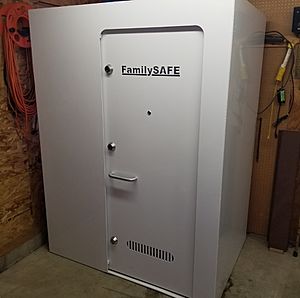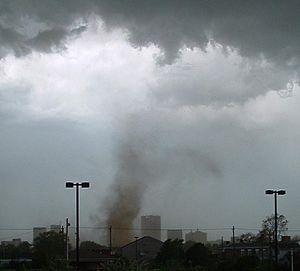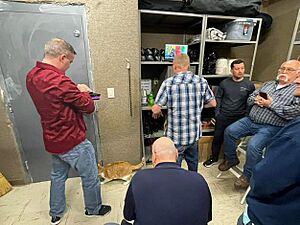Tornado preparedness facts for kids
Tornado preparedness means taking important steps to stay safe before, during, and after a tornado. These steps can change based on where you live and how much warning time you have. For instance, in the countryside, people might use an outside storm cellar. In cities, people might go to a strong inner room. Since tropical storms can also create tornadoes, preparing for hurricanes often includes tornado safety too. Many groups, like government agencies, schools, and emergency teams, teach about tornado preparedness.
Contents
Understanding Tornado Dangers
Tornadoes are some of nature's most powerful storms. They can be very strong and sometimes hard to see. They form from severe thunderstorms. Tornadoes can cause a lot of damage and harm in just a few seconds.
A tornado is a spinning, funnel-shaped cloud. It reaches down from a thunderstorm to the ground. Its winds can swirl as fast as 300 miles per hour (480 km/h). Imagine traveling the length of a football field in just one second! Tornadoes can create damage paths over 1 mile (1.6 km) wide and 50 miles (80 km) long.
Not all tornadoes are easy to spot. A tornado's funnel might be clear until it picks up dirt and debris. Rain or low clouds can also hide them. Sometimes, tornadoes form so fast that there is little warning.
Before a tornado hits, the wind might calm down. The air can become very still. A cloud of dust or debris can show where a tornado is, even if you cannot see the funnel. Tornadoes usually happen at the back edge of a thunderstorm.
Here are some facts about tornadoes:
- They can strike quickly, with little warning.
- They might look clear until they pick up dust.
- In the U.S., they often move from Southwest to Northeast. But they can move in any direction.
- A tornado's average speed is 30 miles per hour (48 km/h). It can range from standing still to 70 mph (110 km/h).
- Tornadoes can also happen with tropical storms and hurricanes when they reach land.
- Waterspouts are tornadoes that form over water.
- Tornadoes are most common east of the Rocky Mountains. This happens during spring and summer.
- The busiest tornado season in the southern U.S. states is March through May. In northern states, it is late spring to early summer.
- Tornadoes are most likely between 3 p.m. and 9 p.m. local time. But they can happen at any time.
Preparing for Incoming Storms
The U.S. Federal Emergency Management Agency (FEMA) suggests these steps before a storm arrives:
- Pay attention to changing weather.
- Listen to NOAA Weather Radio or local news for updates.
- Watch for common danger signs, such as:
- Large hail stones.
- A big, dark, low-lying cloud, especially if it is spinning.
- A loud roar of wind, like a freight train.
If you see a storm coming or notice any danger signs, get ready to take shelter right away. Go to a safe room, an inside stairway, or another safe spot.
Every family should have a disaster preparedness kit ready. FEMA says this kit should have items you need to stay safe for up to 72 hours after a tornado.
What to Do During a Tornado
To stay safe during a tornado, wear strong shoes or boots, a helmet, long sleeves, gloves, and a heavy blanket or coat. These items can protect you from flying glass, splinters, and other objects.
Before a tornado is expected, the Department of Homeland Security suggests having these basic items: Basic Items
- Water
- Food
- Tools / Emergency Supplies
- First Aid Supplies
- Clothing and Bedding
- Special Needs Items
They also advise refilling medicines, getting extra cash, filling your car with gas, and having extension cords. You might also consider booking a hotel more than 50 miles away for a few nights after the tornado.
In August 2010, FEMA shared these actions for when a tornado strikes:
| Location | Action to Take |
|---|---|
|
Inside a building (like a home, school, or store) |
Go to a safe place like a safe room, basement, storm cellar, or the lowest floor. If there is no basement, go to an inner room on the lowest level (like a closet or hallway). Stay away from corners, windows, doors, and outside walls. Try to put as many walls as possible between you and the outside. Get under a strong table and use your arms to protect your head and neck. Do not open windows. |
|
In a vehicle, trailer, or mobile home |
Leave immediately. Go to the lowest floor of a strong building nearby or a storm shelter. Mobile homes offer little protection, even if tied down. If a car flips, there is also danger from broken glass. |
|
Outside with no shelter |
Lie flat in a ditch or low area. Cover your head with your hands. Be aware of possible flooding in ditches. Do not stay under an overpass or bridge. Winds and debris can be funneled there. It is safer to be in a low, flat spot. Never try to outrun a tornado in a car or truck in busy areas. Leave your vehicle and find safe shelter. Most injuries and deaths from tornadoes come from flying debris. |
Safety plans can differ by location. Always check your local area's plans. Do not assume they are the same everywhere. Find out which local buildings are designated as storm shelters.
A 2012 study showed that wearing a helmet, like for football or biking, can help reduce head injuries and deaths. The CDC recommended general head protection. They also said to keep helmets close by to save time.
After the 2013 Moore tornado, many people tried to leave the area. This helped reduce the number of deaths. However, some people were harmed when the tornado hit traffic jams caused by the quick evacuation. Flash flooding from thunderstorms can also make evacuation hard. It is also important to know the tornado's exact path and direction. Other people who did not leave the Moore tornado were also harmed because their buildings were completely destroyed. This shows why storm shelters and safe rooms built to withstand very strong winds are so important.
After a Tornado: Safety Steps
When cleaning up after a tornado, wear thick-soled shoes or boots, long pants, and work gloves.
Be careful to avoid injuries from electric shock, sharp debris (nails, glass, wood), dirty water, and carbon monoxide poisoning.
Long-Term Safety Planning
Different areas have different safe places. The goal is to avoid outer walls that might collapse. Inner rooms often hold up longer because their smaller walls are connected. Outer walls take the full force of the wind. Mobile homes usually lack strong foundations. They also have large surfaces that catch the wind. So, it is best to find a safe place elsewhere, like a stronger building. When a mobile home rolls, people can get hurt by hitting objects inside or being crushed.
In a multi-story building, an inner stairway can be a safe spot. The stairs reinforce the walls and block falling debris. If a stairway has many windows, flying glass could be a danger. An interior stairway or small inner room is better.
In private homes, some people use similar stairway rooms. Or they keep an inner room or closet clear for quick entry. This is for when a storm is seen or heard approaching. The wind's roar gets louder, sounding like a fast "freight train". With more time, you can build an inner safe room. This room can hold emergency water, food, flashlights, and a phone. This way, you can call for help if debris blocks the exit. Some above-ground safe rooms are built with steel-rebar rods in cement-filled cinder blocks. These can withstand 250 miles per hour (400 km/h) winds. Rural homes might have an outside storm cellar or bunker. This helps avoid being trapped in a collapsing house. In rural homes, generators are also useful to keep power for a few days.
Before the 2011 Joplin tornado, there were no building codes specifically for tornado shelters. After that event, a local rule required hurricane ties or similar fasteners. Oklahoma adopted minimum U.S. standards that year. However, they did not add high-wind protections like those in Florida for hurricanes. Other states in Tornado Alley do not have statewide building codes. The National Association of Home Builders has concerns about the cost of "safe rooms." The chance of a specific spot in Tornado Alley being hit by a strong F-2 tornado is about 1 in 4,000-5,000 years. In other areas, it is even less likely.
The U.S. Federal Emergency Management Agency has spent millions of dollars. This money helps build shelters and safe rooms in both private and public buildings. Many buildings in Tornado Alley do not have basements. This is because deep foundations are not needed for frost lines there. Also, the water table can be high in some places. Clay-heavy soils can also put pressure on buildings, causing leaks if not reinforced.
North of the equator, tornadoes usually travel between north and east. They often cause the most damage on the southwest corner of buildings. The north side and northeast corner are often safest. Professor Joseph Eagleman found that 75 percent of homes hit were most damaged in the southwest corner. He found the southwest corner and south side were the least safe. South of the equator, the south side and southeast corner were safest.
Medical Preparedness
Having a first aid kit in your safe place is important. It can help with minor injuries. People who need prescription medications should have a medicine bag ready to take to shelter. Some people have felt their "ears popping" due to air pressure changes. These effects usually do not last long. Covering people with mattresses or cushions has helped prevent injuries from flying debris when walls collapsed nearby.
Injuries from tornadoes can vary. The most common injuries are complex soft tissue wounds. These make up over 50% of cases seen in emergency rooms after a tornado. These wounds are often dirty with soil and foreign objects due to high winds. Fractures are the second most common injury, making up about 30% of all injuries. Head injuries are also common, but severe head injuries are less than 10% of the total. Even though severe head injuries are rare, they are the most common cause of death after a tornado. Injuries to the chest and abdomen also happen but are less than 10% of all injuries.
Tornado Drills
Tornado drills, also called severe weather drills, are a key part of tornado preparedness. Like other safety drills, they help you respond correctly during a real tornado threat.
Many states in the Midwest and Southern U.S. hold a statewide tornado drill. This happens in late winter or early spring to get ready for severe weather season. During these drills, the National Weather Service sends out test tornado warnings. Local Emergency Alert Systems and NOAA Weather Radio are activated. Outdoor warning sirens also sound. Schools and businesses may do a tornado drill at the same time.
A tornado drill is a practice to take cover in a specific place if a tornado hits. This safety drill is a very important part of tornado preparedness.
Usually, a signal is given, like a series of sounds or a voice announcement. When the signal is heard, people in schools, hospitals, factories, and stores go to a special spot. This is usually an inner room or hallway with no windows. They then get into a protective position.
In homes and small buildings, you should go to the basement. Or go to an inner room on the lowest floor, like a closet or bathroom. Stay away from glass.
If you are in a car or mobile home, you must leave it. This is unless you have a good chance to drive away to safety.
Some areas require schools to have regular tornado drills. These are usually less often than fire drills.
During school tornado drills, students often huddle against the walls of the building, usually in a hallway. This helps protect them. Staff members, like teachers, also huddle against the wall for safety.
See also
- Tornado myths
- Derecho
- Secondary flow
- Tornadoes of 2025
- Cultural significance of tornadoes
- List of tropical cyclone-spawned tornadoes
- List of tornadoes and tornado outbreaks
- List of tornado-related deaths at schools
- Whirlwind (atmospheric phenomenon)
- Microburst
- Emergency management
- Tropical cyclone warnings and watches
- Tornado watch
- Tornado warning





